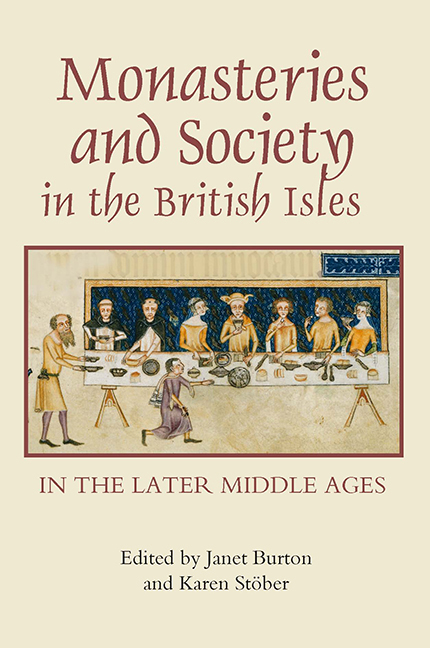Book contents
- Frontmatter
- Contents
- List of illustrations
- Acknowledgements
- List of contributors
- Abbreviations
- Introduction
- The Meeting of the Worlds
- 1 The social networks of late medieval Welsh monasteries
- 2 Cistercian hospitality in the later Middle Ages
- 3 Cistercians and border conflicts: Some comparisons between the experiences of Scotland and Pomerania
- 4 ‘Not a thing for a stranger to enter upon’: The selection of monastic superiors in late medieval and Tudor England
- Religious Houses and their Patrons and Benefactors
- Female Communities: Nuns, Abbesses and Prioresses
- Monasteries and Education
- Monasteries and Urban Space
- Religious Houses in the Regions
- Index of Religious Houses mentioned in the text
- Index
- Miscellaneous Endmatter
3 - Cistercians and border conflicts: Some comparisons between the experiences of Scotland and Pomerania
from The Meeting of the Worlds
Published online by Cambridge University Press: 24 October 2017
- Frontmatter
- Contents
- List of illustrations
- Acknowledgements
- List of contributors
- Abbreviations
- Introduction
- The Meeting of the Worlds
- 1 The social networks of late medieval Welsh monasteries
- 2 Cistercian hospitality in the later Middle Ages
- 3 Cistercians and border conflicts: Some comparisons between the experiences of Scotland and Pomerania
- 4 ‘Not a thing for a stranger to enter upon’: The selection of monastic superiors in late medieval and Tudor England
- Religious Houses and their Patrons and Benefactors
- Female Communities: Nuns, Abbesses and Prioresses
- Monasteries and Education
- Monasteries and Urban Space
- Religious Houses in the Regions
- Index of Religious Houses mentioned in the text
- Index
- Miscellaneous Endmatter
Summary
The political, social and economic landscape of Europe changed significantly between the twelfth and the fourteenth centuries. This change was also very noticeable in the ways in which religious houses functioned and interacted with the society around them. The traditional view, which now survives only in popular literature, presents a contrast between the image of twelfth-century monastic life – one of strictness and simplicity – with that of the ‘corruption’ of the fourteenth century and beyond. Although this antithesis is clearly oversimplified, there is no doubt that for Cistercian houses in many ways – the layout of their precincts, the use of their buildings, their economic activities and the very character of their contacts with the lay world – their lives were very different by the late Middle Ages from what they had been in the twelfth century. In many respects these changes reflect what happened in the broader society from which the members of the monastic communities were recruited. For example, the appearance of individual cells for monks instead of communal dormitories reflects the greater attention given to the comforts of life among the nobility and wealthy urban classes in the later Middle Ages.
The Cistercian Order became significantly fragmented by the fourteenth century and based more around national boundaries than the earlier pan-European network. This was to a large extent a result of the papal schism between 1378 and 1417. The support offered to different popes by Cistercian monasteries in different parts of Europe contributed to the formation of the national provinces of the Cistercian Order in the early fifteenth century. The impact of change was not uniform throughout Europe and the two regions that are discussed here show particularly striking and important characteristics.
The northern frontiers of Europe had witnessed rapid and successful expansion of Cistercian monasticism in the twelfth century, but in the fourteenth century they became subject to violence and economic pressure on a significant scale. The contrast between the situations in these two centuries is symptomatic of a shift in the character of the frontier regions and changes in the importance of borders. On a generalised level it can be said that borders in the earlier period were permeable and much less linear than in the fourteenth century, and that this had a significant impact on the monasteries in the frontier regions.
- Type
- Chapter
- Information
- Publisher: Boydell & BrewerPrint publication year: 2008



